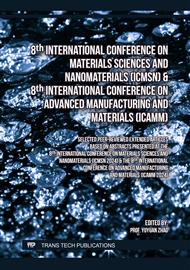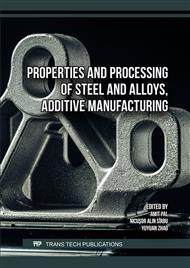[1]
A. Nigam and B. L. Tai, "Effects of in-process surface finishing on part strength in polymer material extrusion additive manufacturing," Addit Manuf, vol. 80, p.103960, Jan. 2024.
DOI: 10.1016/j.addma.2024.103960
Google Scholar
[2]
Torres, J., Abo, E. and Sugar, A.J. (2023), "Effects of annealing and acetone vapor smoothing on the tensile properties and surface roughness of FDM printed ABS components", Rapid Prototyping Journal, Vol. 29 No. 5, pp.921-934
DOI: 10.1108/RPJ-03-2022-0088
Google Scholar
[3]
A. A. Demircali, D. Yilmaz, A. Yilmaz, O. Keskin, M. Keshavarz, and H. Uvet, "Enhancing mechanical properties and surface quality of FDM-printed ABS: A comprehensive study on cold acetone vapor treatment," The International Journal of Advanced Manufacturing Technology, vol. 130, no. 7–8, p.4027–4039, Feb. 2024.
DOI: 10.1007/s00170-023-12929-2
Google Scholar
[4]
N. Sathishkumar, N. Arunkumar, L. Balamurugan, L. Sabarish, and A. Samuel Shapiro Joseph, "Investigation of Mechanical Behaviour and Surface Roughness Properties on Copper Electroplated FDM High Impact Polystyrene Parts," in Lecture Notes on Multidisciplinary Industrial Engineering, vol. Part F164, 2020.
DOI: 10.1007/978-981-32-9433-2_25
Google Scholar
[5]
A. W. Hashmi, H. S. Mali, A. Meena, S. Ahmad, and Y. Tian, "A novel eco-friendly abrasive media based abrasive flow machining of 3D printed PLA parts using IGWO and ANN," Rapid Prototyp J, vol. 29, no. 10, 2023.
DOI: 10.1108/RPJ-04-2023-0136
Google Scholar
[6]
B. Taghizadeh, M. V. Ehteshamfar, and H. Adibi, "Lapping optimization of additively manufactured ABS-carbon fiber composite parts using the soft computing technique," Polym Test, vol. 128, p.108241, Nov. 2023.
DOI: 10.1016/j.polymertesting.2023.108241
Google Scholar
[7]
S. Swirad, "Changes in Areal Surface Textures Due to Ball Burnishing," Materials, vol. 16, no. 17, 2023.
DOI: 10.3390/ma16175904
Google Scholar
[8]
A. Sood and B. Mullany, "Advanced surface analysis to identify media-workpiece contact modes in a vibratory finishing processes," in Procedia Manufacturing, 2021.
DOI: 10.1016/j.promfg.2021.06.077
Google Scholar
[9]
M. R. Khosravani, M. R. Ayatollahi, and T. Reinicke, "Effects of post-processing techniques on the mechanical characterization of additively manufactured parts," J Manuf Process, vol. 107, p.98–114, Dec. 2023.
DOI: 10.1016/j.jmapro.2023.10.018
Google Scholar
[10]
J. S. Dai, P. M. Taylor, P. Sanguanpiyapan, and H. Lin, "Trajectory and orientation analysis of the ironing process for robotic automation," International Journal of Clothing Science and Technology, vol. 16, no. 1–2, 2004.
DOI: 10.1108/09556220410520496
Google Scholar
[11]
M. Sardinha, J. Lopes, A. Gusmão, L. Reis, and M. Leite, "Ironing process influence on the warping of ABS parts produced by Fused Filament Fabrication," in Procedia Structural Integrity, 2022.
DOI: 10.1016/j.prostr.2022.12.162
Google Scholar
[12]
M. Caputo, O. Rashwan, D. Waryoba, and K. McDade, "Surface texture and thermo-mechanical properties of material extruded and ironed polylactic acid," Addit Manuf, vol. 59, 2022.
DOI: 10.1016/j.addma.2022.103084
Google Scholar
[13]
J. D. Kechagias and S. P. Zaoutsos, "An investigation of the effects of ironing parameters on the surface and compression properties of material extrusion components utilizing a hybrid-modeling experimental approach," Progress in Additive Manufacturing, Nov. 2023.
DOI: 10.1007/s40964-023-00536-2
Google Scholar
[14]
H. Alzyod, J. Takacs, and P. Ficzere, "Improving surface smoothness in FDM parts through ironing post-processing," Journal of Reinforced Plastics and Composites, Apr. 2023.
DOI: 10.1177/07316844231173059
Google Scholar
[15]
H. García de la Torre, G. Gomez-Gras, A. Chueca de Bruijn, and M. A. Pérez-Martínez, "Enhancement of mechanical and surface properties by ball burnishing process on polymeric components obtained by FFF," Rapid Prototyp J, vol. 29, no. 8, 2023.
DOI: 10.1108/RPJ-12-2022-0424
Google Scholar
[16]
B. Neuhaus, M. K. Idris, P. Naderi, Y. El‐Hajj, and G. Grau, "Low‐Roughness 3D‐Printed Surfaces by Ironing for the Integration with Printed Electronics," Adv Eng Mater, Jan. 2024.
DOI: 10.1002/adem.202301711
Google Scholar



